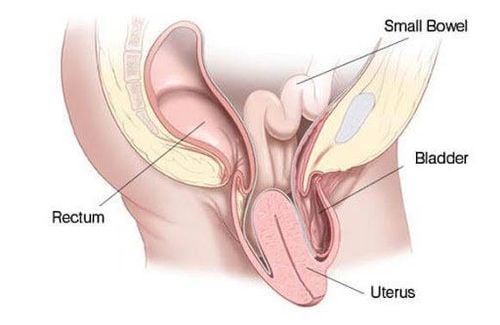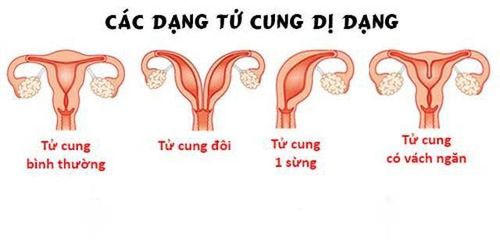This is an automatically translated article.
The article was professionally consulted by Specialist Doctor II Le Minh Viet - Anesthesiologist - General Surgery Department - Vinmec Ha Long International General Hospital.General anesthesia in uterine malformation surgery is a method used in complicated surgical cases. This method will be contraindicated for people who are allergic to certain anesthetic drugs.
1. What is general anesthesia?
General anesthesia is a combination of different drugs (anesthesia - central analgesia - muscle relaxants...) with the aim of making the patient unaware of what is happening around them, in terms of medically known as coma. Prevent pain and paralysis during surgery. General anesthesia is the strongest type of anesthetic used during surgery.Patients under general anesthesia need a ventilator to do the work of the diaphragm and other respiratory muscles, making it possible for the patient to breathe. There are many ways of general anesthesia such as: endotracheal anesthesia, anesthesia through laryngeal mask, ...
General anesthesia is used for important and prolonged surgery, often causing pain. This type of anesthesia not only makes the patient pain-free during surgery, but also makes it easier for the doctor to perform the surgery while the patient is still.

Gây mê toàn thân giúp vô cảm và giảm đau sau phẫu thuật
2. Uterine malformation surgery
2.1 Uterine malformation
2.1 Uterine malformation Uterine malformation is a morphological abnormality of the uterus. There are many types of uterine malformations such as:No uterine morphology Double uterus Separated uterus Communicating uterus Hypoplastic uterus Depending on the degree of uterine malformation, the doctor will prescribe intervention laparoscopic or open surgery. At the same time, based on that to choose the appropriate anesthetic method. In cases of uterine malformation surgery, the doctor will prescribe general anesthesia. General anesthesia is contraindicated in patients who are allergic to anesthetic drugs such as: muscle relaxants, anesthetics, morphine family drugs, ... and cases of neuromuscular disease.

Gây mê toàn thân chống chỉ định với trường hợp người bệnh bị nhược cơ
2.2 Performing general anesthesia in uterine malformation surgery
Step 1: PrepareThe person performing general anesthesia in uterine malformation surgery for the patient is a nurse and an anesthesiologist. In addition, some tools need to be prepared such as:
Anesthesia machine, endotracheal lamp, suction machine, endotracheal tube, Endotracheal suction tube, Syringe pump of all kinds: used to inject drugs and inflate balloons to insert endotracheal tubes. trachea Drugs used in anesthesia: diprivan tube 200 mg/20ml, tracurium tube 25mg/2.5ml or esmeron tube 50mg/5ml, and fentanyl tube 0.1mg/2ml. Infusion fluids of all kinds: ringer lactate, ringerfundin,... Etroley emergency vehicle Before performing anesthesia surgery, the patient needs to prepare psychologically and be explained by the doctor about the purpose and possible complications. . The patient will then sign the pledge. Note, do not eat or drink for at least 6 hours before surgery.

Bệnh nhân cần nhịn ăn trước khi thực hiện phẫu thuật
Check the heart, lungs and prognosticate the risk of intubation Place a peripheral intravenous line and give ringer lactate or ringerfundin solution Get a monitor to monitor vital signs: Respiratory rate, pulse, temperature, blood pressure, oxygen saturation. Give the patient a CPAP mode of self-breathe to increase the oxygen reserve before induction of anesthesia Initiating general anesthesia for the patient:
Inject Fentanyl 2-3mcg/kg, then inject Diprivan with a dose of 2-2.5 mg/kg . When the patient has lost consciousness, inject the muscle relaxant Esmeron at a dose of 0.6 - 0.8 mg/kg. If it is a short surgery or the patient has kidney failure, use Tracurium 0.6-1 mg/kg. Conduct intubation after 1 minute, inflate the balloon to insert the endotracheal tube. Locate the correct tube when listening to the lungs shows clear bilateral alveolar murmurs and on the electrocardiogram there are waves typical of the correct endotracheal tube. Fix the endotracheal tube and put the patient on a ventilator. Anesthesia should be maintained with an inhaled anesthetic such as Isoflurane or Sevofluran 0.5 - 1 MAC, or with intravenous anesthetic Diprivan 6 - 9 mg/kg/hour. Carrying out urinary catheterization Initiating antiseptic and surgical procedures. Closely monitor vital signs such as: pulse, blood pressure, capillary oxygen saturation and especially CO2 pressure at the end of expiration Monitor depth of anesthesia based on heart rate, blood pressure, ventilator parameters : airway pressure, frequency,... And symptoms such as sweating, lacrimation (PRST), MAC, BIS and Entropy (if any)... Before exiting anesthesia, remove the patient's surgical tube. Uterine malformations with open surgery will be anesthetized on both sides of the lumbar squamous muscle to reduce postoperative pain End of surgery for the patient to practice breathing through the endotracheal tube, extubate the trachea when the patient is awake, on command, breathing well , pulse, blood pressure is stable and the effect of muscle relaxants is gone.
2.3 Monitoring and handling of accidents
After surgery, the patient will be monitored in the recovery room and continue to breathe oxygen through the nose at a dose of 3-5 liters / minute. Monitor vital signs such as pulse, temperature, blood pressure, breathing rate, oxygen saturation,... bleeding status and drainage if any.General anesthesia in uterine malformation surgery can cause some complications such as:
Gastroesophageal reflux: If there is digestive fluid in the oral cavity and the airways need to be drained, and Have the patient lie with the head low and to the side. Especially monitor and prevent lung infections after surgery. Hemodynamic disorders: Cardiac arrhythmias, hypotension or high blood pressure Intubation complications such as: failure to intubate, mistakenly placed in the stomach, bronchospasm, trauma, bleeding, broken teeth,... Respiratory complications: retraction or opening of the respiratory system, folding, retraction of the endotracheal tube being pushed deep into one lung,... Complications after extubation: failure respiratory, sore throat, hoarseness, upper respiratory tract infection, laryngotracheal stenosis, ...

Suy hô hấp là một tai biến có thể xảy ra sau phẫu thuật
Vinmec International General Hospital with a system of modern facilities, medical equipment and a team of experts and doctors with many years of experience in medical examination and treatment, patients can rest assured to visit. examination and treatment at the Hospital.
Specialist II Le Minh Viet has more than 30 years of experience in the field of Anesthesia - Resuscitation, including more than 2 years as a Medical expert in Yemen and former Head of Anesthesia - Resuscitation Department - Hospital Thanh Nhan, Hanoi. Currently, Dr. Le Minh Viet is an anesthesiologist, Anesthesia Unit - operating room, Vinmec Ha Long International Hospital.
To register for examination and treatment at Vinmec International General Hospital, you can contact Vinmec Health System nationwide, or register online HERE.













